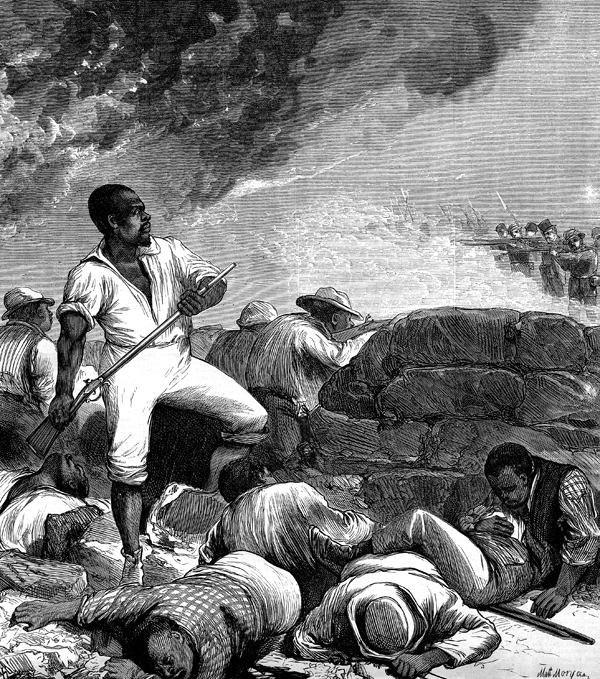Colfax Massacre
In 1873 white Louisianans responded to Reconstruction policies with violence, resulting in the Colfax Massacre.

Courtesy of The Historic New Orleans Collection.
Black-and-white reproduction of an illustration entitled, “Louisiana - Scene Of The Hostilities In Grant Parish, Near New Orleans - Massacre Of The Negroes At Colfax Court House”
Editor’s Note: Warning, this entry contains graphic imagery.
The Colfax Massacre of 1873, also known as the Colfax Riot, was the deadliest incident of racial and political violence during the Reconstruction era, claiming the lives of at least sixty and perhaps as many as 150 men. Nearly all of the victims were African American. The confrontation elevated the standing of white supremacist organizations in Louisiana and the South. The Colfax Massacre is remembered as a signal event in the establishment of the Jim Crow system, for it led to United States v. Cruikshank (1875), a Supreme Court decision that disallowed the federal prosecution of racially motivated crimes.
The Disputed Election of 1872
In an era characterized by extreme and repeated restructuring of election laws and practices, the elections of November 1872 produced disputed results and a divided government in Louisiana. The contest pitted Radical Republicans allied with President Ulysses Grant and the US Congress against a “Fusion Ticket” of conservative Democrats and liberal Republicans sympathetic to the cause of home rule in the South. Because neither party recognized the legitimacy of the other side’s claim to victory, two sets of officials laid claim to every office in the state. In Grant Parish, the establishment of dual governments led to a contest for control of the courthouse in Colfax, a rural outpost and Radical stronghold on the Red River.
The Radicals claimed the offices of sheriff and judge for party stalwarts Dan Shaw and R. C. Register. Fusionists insisted that voters had favored Christopher Columbus Nash for sheriff and Alfonse Cazabat for judge. Led by members of a disbanded Black militia unit, the Radical faction gained control of the courthouse building and began to form a sheriff’s posse in defense of its position. White men from Grant and nearby parishes organized their own ranks, mustering volunteers from as far as one hundred miles away.
The Battle of the Colfax Courthouse
After weeks of mounting tension and incidents of violence, the confrontation at Colfax erupted on Easter Sunday, April 13, 1873. Hundreds of Black people, including women and children as well as dozens of men with guns, had gathered in the vicinity of the courthouse. A white force of 150 or more announced its intention to attack and made time for the safe passage of noncombatants from the site. Armed with a small cannon, mounted white men forced most of the defenders inside the courthouse and set fire to the building. As some of the men inside the courthouse tried to arrange for surrender, other participants fired their weapons. Two white men died, including James West Hadnot, thought to be the leader of the local white supremacist organization, the Knights of the White Camellia.
Enraged by the killings, white participants began firing at the crowd of Black militants near the courthouse door. A general slaughter ensued, as the African Americans scattered and the white men rode off in pursuit. A large number of men emerged from the burning courthouse to be detained as prisoners on a site nearby.
The Massacre
Late in the evening, white participants began to dispute the wisdom of releasing their Black prisoners, as members of families drew close to the courthouse site. Led by the sons of James Hadnot, a group of militants proceeded to execute their captives. Members of the prisoners’ families served as eyewitnesses to the killings, most of which were shots to the head. A white participant estimated the total number of victims to be forty-eight, but a few survived to testify against the perpetrators in court proceedings.
United States v. Cruikshank
State officials investigated the scene of the violence and assisted in the burial of fifty-nine bodies. The US attorney in New Orleans, James Beckwith, prepared an indictment and commissioned federal marshals to arrest suspected organizers on the white side. His authority derived from the Enforcement Acts of 1870 and 1871, which created a special code of federal criminal offenses to fight Klan violence. Hundreds of African American and white witnesses testified in the case United States v. Columbus Nash, later renamed United States v. Cruikshank, because the lead defendant remained at large.
The jury convicted three of the men on charges of conspiracy, but federal Circuit Court and Supreme Court rulings threw out the convictions and all charges and invalidated key sections of the Enforcement Acts. After 1875, the full responsibility for prosecuting racial and political crimes would rest with the states. Southern courts and elected officials increasingly favored white supremacy and turned a blind eye to Klan-style violence and repression.
Historical Marker
In 1950 the Louisiana Department of Commerce and Industry erected a state historical marker on the site of the Grant Parish Courthouse under the title “Colfax Riot.” The marker declares, “On this site occurred the Colfax Riot in which three white men and 150 Negroes were slain. This event on April 13, 1873 marked the end of carpetbag misrule in the South.” The marker, long a subject of community controversy due to its gross misinterpretation of the event and its consequences, was removed by the Office of Louisiana Economic Development (successor to the state office that erected the marker) on May 15, 2021. A new memorial to the victims of the massacre was unveiled on the 150th anniversary of the massacre, on April 13, 2023.
